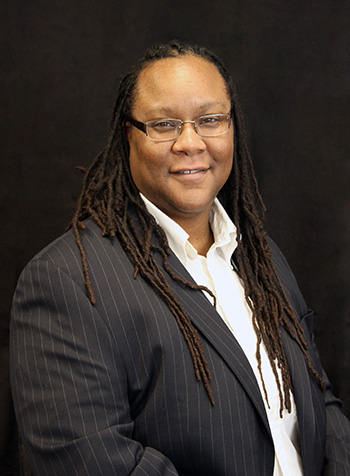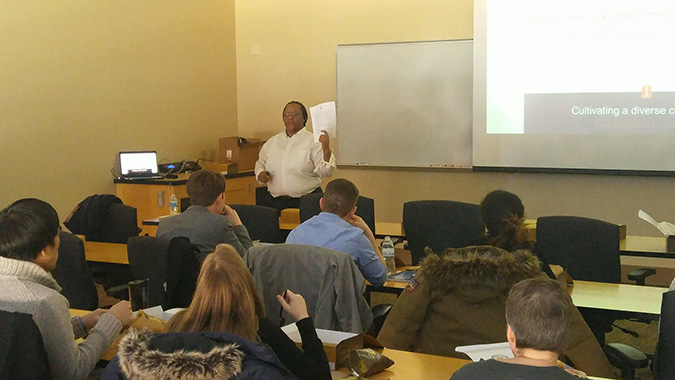“Double Bind” Study Examines Obstacles Women of Color Face in Engineering
“You don’t want diversity just for the sake of diversity, don’t want them just for the sake of having them in the room. You want them for their perspective.” – Kelly Cross

Kelly Cross, BioEngineering Visiting Research Scientist (photo courtesy of the Engineering Education Research Group)
April 10, 2017
Kelly Cross and several colleagues have begun a three-year study funded by the National Science Foundation to examine the experiences of women of color in engineering. Aptly named “The Double Bind of Race and Gender: A Look into the Experiences of Women of Color in Engineering,” the study Cross is conducting, along with Jenny Amos, Kathryn Clancy, Princess Imoukhuede, and Ruby Mendenhall, is looking at how women of color are doubly disadvantaged. They not only have to overcome historical gender inequities inherent in engineering, but also face the many challenges racial minorities encounter.
Begun in September 2016, the three-year study (an unexplored facet of Cross’s dissertation she is finally getting to pursue) involves a survey open to all women in the College of Engineering in a large, Midwestern, public, research-intensive school, plus interviews, to be conducted in the immediate future.
To recruit engineering women to take part in the study, the investigators created an email briefly describing the study and providing a link to the survey. Then, just before Christmas break in December 2016, the directors of Engineering undergraduate programs, like the Society of Women in Engineering, sent the email out to their memberships. To date, 400 participants have responded; 300 have completed the survey, with less than 50 women of color. The investigators intend to repeat the survey again next fall.
Additionally, to delve deeper into students’ experiences, Cross and colleagues will also conduct individual interviews with all survey respondents who volunteered to be interviewed further about the topic.
Both the survey and interviews will deal with identity, which Cross calls "The core piece of this,” while the guiding theoretical framework is intersectionality, which "basically says that you have multiple ways in which you experience anything,” Cross explains.
She describes how identity intersectionality works via a personal example. She identifies as “A black, female engineer—those are three different identities—that’s my race, my gender, and my profession. And intersectionality simply says that I can’t separate those out. I experience them all at the same time. And they interact with each other. So in different contexts, my race becomes more salient, or becomes more important in a particular context.”
She clarifies that during our interview, her identity as a professional engineer was at the forefront. “Not so much my race, or my gender, my religion, or my socioeconomic status. None of that matters. Right now, as a researcher, and as a representative of this department, I need to be a professional engineer. So the context determines which one of these dimensions of identity become more important to us.”
While the grant specifically focuses on women of color, Cross says they will obtain data regarding obstacles all women must overcome to study engineering. “We did want to capture women’s experience in engineering. Period.” She also expects to capture other things they didn’t necessarily target in the study, such as one they discovered early on regarding White women’s racial identity.
“White women don’t always consider their race,” she admits, “because they’ve never had to define or think about their race. So having them in a setting where they could actually think about their race was a kind of unintended tidbit of information that we didn’t intend to collect, but was certainly there.”
She was excited to “actually have data to say that not all white women think about their race because they’re never really forced to,” a concept she was familiar with as a researcher, adding that this survey gave them the opportunity to reflect on, ‘What does it mean for me to be a white female?’ and reports that, based on the data so far, white women’s experiences and what they thought about race were completely different than what students of color thought.
Based on previous literature, "Identity development around race is very different for whites than it is for ethnic minorities," she states. "...If you’re a majority person, you don’t necessarily think about your race and what it means, whereas a minority person, they constantly think about ‘What is my race? What does it mean? How is it impacting my experience?’”
“Race is a socially constructed thing,” Cross continues, shedding further light on how the term “white” came about historically in the U.S. According to Racial Formation in the United States, immigrants to America originally considered themselves to be German Americans, Irish Americans, or Italian Americans, etc.
“But this conception of white came along to basically stratify the population,” Cross elucidates. “Now that you’re making laws regarding that, you need this terminology to justify making laws and segregating the population,” Cross explains. “But, no, originally they were German Americans; they were not white; they were Italian Americans; they were not white. But now we know them all as white.”
However, Cross indicates that there’s a trend now among people in the white community saying ‘No, you can’t just throw me in this white pile…People are saying, ‘Hey, I want to hang on to that. I’m not saying that I’m not American, but what I am saying is that I do have some history behind it.’”
What do the investigators hope will come out of the study? One noteworthy end product mentioned in their proposal abstract is a “framework and model that women of color can use to overcome challenges that they might face in engineering and other STEM disciplines.”
Although they’ve gathered some data thus far, Cross says it’s too early to make any predictions as yet regarding what that framework might look like, or any other programs they might like to put in place: “We have to see what our data are telling us first. Because this is such an unexplored area, it is very difficult to propose a solution when we don’t completely understand the problem.”
So, to help them more fully understand the problem, the next step is interviews to find out which of the women's identities are impacting their experiences in certain situations: the classroom, when talking to an advisor or TA, or in a student group environment.
“So in those different educational environments and settings, whatever they described as important to their academic experience here, we want to ask them, ‘Ok, now that you’ve articulated that, was it your race? Was it your gender? What do you think was most influential in that interaction?”
Another mitigating factor when extrapolating from the data is what departments women are in,
“Because the departmental culture for women also varies,” Cross admits.
She goes on to describe the differences between, say, Bioengineering (BioE), where half of the engineering students are female, and other departments. “So our culture in this department will be very different from ECE (Electrical and Computer Engineering) or even ISE (Industrial and Enterprise Systems Engineering).”
Part of this involves women's sense of belonging—whether students feel welcome and included within their department. For example, Cross recently discovered that women in some departments have formed student groups to support each other. But she reports that while (Mechanical Science Engineering has a group for female students, BioE doesn’t—ostensibly because with BioE’s high ratio of female vs. male students, women don’t have a diminished sense of belonging.
Cross-departmental differences could be significant. For instance, ECE, with its sheer numbers, “is absolutely going to function and look differently," Cross explains. "But, again, this is where I think intersectionality is so important.” She believes it will prevent them from making any gross generalizations.
“That is why it is important to talk to them, for them to tell us what is going on, and what becomes more salient for them, and why? Because we don’t know the ‘why?’ either.”
What potential impact could the study have? Cross believes the study could aid in reforming engineering education here at Illinois.
For example, she believes it will be useful in the work she’s doing to redesign engineering curriculum. As part of another NSF initiative, RED (Revolutionizing Engineering Departments), she’s working with faculty on “how to be more inclusive in their teaching practices.” Further, she hopes to take, “what women are saying about their classroom experience back to our faculty, to say, ‘In your department, your women are having trouble with this.’”
Cross is also hopeful that the study will provide the impetus for some much-needed dialogue regarding fostering diversity and inclusion: “But I think that this will be a useful lens for us to do a meaningful thing, and start conversations that we have not had in engineering before. So for me, as a black engineering woman, I think it’s important that we start these conversations, because as long as people are not talking, then we can’t learn, and we can’t grow.” And she sees part of her job as an educator “to help people to think, to grow, to go beyond what they think know, and to learn more.”
Ultimately, Cross believes this study could be significant regarding the kind of engineers Illinois produces. She wants every student to have a good experience at Illinois, and reminds other faculty:
“We are training the next generation of engineers, and that is a huge responsibility. What skills do we want or need them to have before they go out into the world and design our world? I don’t want the engineers from this university to leave without understanding the importance of “women is perspective” around the concepts of engineering, how we inform design.”
Along with impacting engineering education here at home, the investigators also believe their study could impact it nationally. For instance, they intend to publish in several journals. Plus, if they can develop “practical teaching practices, there are other venues and journals they can publish in. "Yes, this could take off,” she predicts.
The investigators also hope to seek funding from WEPAN (Women In Engineering Proactive Network), which gives awards for groundbreaking projects. “WEPAN would be huge,” Cross envisions, “because that would be on the national stage.”
While the Double Bind project may seek to address the interests of NSF’s Broadening Participation program, or to right historical inequities and disadvantages, Cross would be the first to say that her main objective is the notion that diverse perspectives are integral to innovative engineering design.
“You don’t want diversity just for the sake of diversity. Don’t want them just for the sake of having them in the room. You want them for their perspective. And that is so key to design, which is the fundamental perspective of what engineering is. We design stuff. And the more perspectives we have, the better the design will be. So achieving a diversity of thought is critical for us as a discipline.”
Story and photographs by Elizabeth Innes, Communications Specialist, I-STEM Education Initiative.
For more articles about Engineering education reform, see:
- Engineering for Social Justice Scholars Program Helps Students Rethink Engineering's Role in Society
More: Engineering, Faculty Feature, Undergraduate Education Reform, Underserved Students/Minorities in STEM, Women in STEM, 2017

Kelly Cross presenting about diversity at a recent workshop.













.jpg)
















